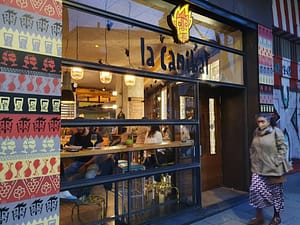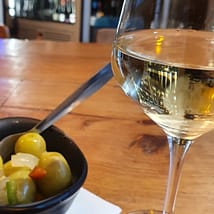La Caníbal is a natural wine bar in the Lavapiés barrio in central Madrid. It’s often called a Galician bar. Maybe because their sister restaurant O Pazo de Lugo is in the other half of the locale. The latter was established back in 1971. (For another natural wine bar in the same neighborhood, read here.)
First time of two at La Caníbal I arrived in the bar without reservation, and I walked into the part that I later came to know as O Pazo de Lugo (pazo being a manor house and Lugo one of the Galician province capitals). While waiting to be seated in the restaurant part I enjoyed a glass of albariño, Albamar 2020. Its creator is Xurxo Alba, whom I met at a fair a few years ago. It’s made with grapes from different parcels in Castrelo, outside Cambados in Rías Baixas. A lovely straw, clean sight; aroma of citrus, pears and stony minerals, a touch of white pepper; quite glyceric, with integrated acidity and a long, saline finish. A small bowl of green olives, onion, paprika was also served while I was waiting.

La Caníbal has a tap system where they serve various wines. Their website insists that they are not bulk wines though, but authentic terroir wines, which their winegrowing friends pack exclusively for them. They can also be bought from their shop in formats such as a two liter bag-in-box.

Bodegas Bentomiz is located in Sayalonga, Málaga (read a report on a visit here). The grapes for this wine are grown predominantly in Córdoba, 90% pedro ximénez. The rest is moscatel from their home farm. Light straw; pear, citrus and flowers; rounded and yet light in the mouth. I don’t know if the wine has a name. Let’s call it Blanco 2020.

They even make wine. Next was collaboratively made by La Caníbal and Marc Isart, for many famous for being formerly part of Comando G of Gredos. But otherwise he is an authority in Spain’s central areas. Las Nieves 2021 is a malvar from a single plot of old vines in Chinchón where the soil is calcareous with clay. Malvar is Madrid’s own variety. It’s most often cultivated high. When paired with airén, another Central Spain cultivar, it tends to be the acidic and aromatic part of the blend. Back to this particular wine: One half is fermented with skins in clay, the other without in oak barrels. It showed a “blushing brown” colour; aroma of mature apples, channel, herbs (thyme) and an earthy tone; in the mouth it played with oxidation, but had adequate acidity and a mineral touch. A fascinating orange wine.
Luís Oliván makes wine in several regions. To La Caníbal he currently delivers a Moristel 2021 for sale on tap and in a one liter bottle. It’s cherry red, simple, juicy and fruity. Pure joy.
El Sueño de las Aforjas of León is the bodega behind the next wine, Prieto Picudo Ecológico 2021, from the variety of that name, matured one year in concrete. Dark cherry; red and dark fruits (blueberry, morello); fine tannins, fresh acidity and a touch sweetness (banana).
Nietos de la Señora María is located in the Alto Alberche area of Gredos. The bodega is located at 1.300 meters altitude and the four brothers who run it are guided by Daniel Ramos, a very clever vinegrower in the area. This wine comes from their ten hectares of garnacha between 40 and 60 years old. Ruby red; aromas of red fruits and herbs; a distinctive granite/pencil flavour, fine-grained tannins and a luscious body. A gastronomic wine. It’s called Garnacha on the board, and the vintage is 2020, by the way.
Fancy some cheese while summing it all up? La Caníbal have their own cheese sommelier. To make the choice easier for you the platters have musical names, like Rock’n’Roll, Indie and Celta. Pick your favourite! Strike your wine chords!











